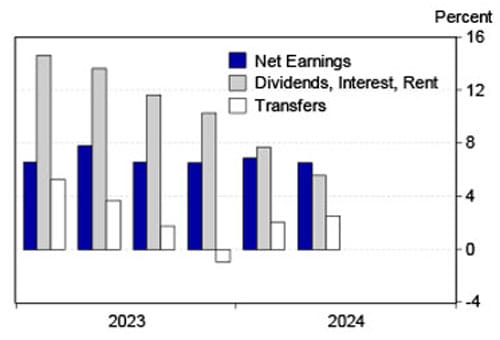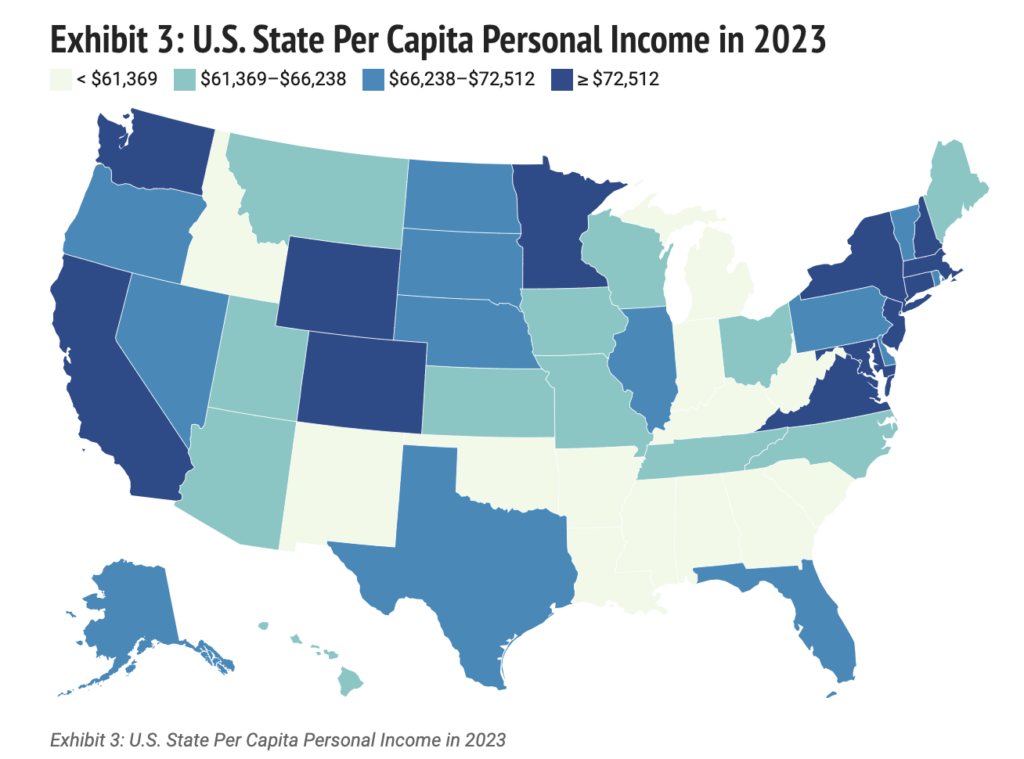State of Arizona personal income growth ranked 23rd in the nation in the second quarter.
Arizona nominal personal income rose 5.2% at a seasonally-adjusted annual rate in the second quarter of 2024, falling slightly short of the nation at 5.3% (Exhibit 1). That ranked Arizona 23rd in the nation. South Carolina generated the fastest growth in the second quarter at 6.9% and North Dakota posted the slowest at 2.3%.
Exhibit 1: Personal Income Growth Across U.S. States, First Quarter 2024 to Second Quarter 2024, Seasonally-Adjusted Annual Rates, Percent

Arizona nominal personal income was up 5.5% over the year in the second quarter of 2024, falling short of the national average of 5.9%. Net earnings from work (wages and salaries, proprietors’ income, and fringe benefits, net of social insurance payments and adjusted for commuting) rose 6.5%, equal to the national pace. Asset income (dividends, interest, and rent) rose 5.6% over the year, outpacing the U.S. at 4.5%. Transfer receipts (Social Security, Medicare, Medicaid, welfare, etc) rose 2.5%, well below the national pace of 5.4%.
As Exhibit 2 shows, Arizona growth in asset income has been decelerating, which likely reflects slower rent growth. Gains in net earnings from work (before adjustment for inflation) have been solid so far this year, but on average slower than in 2023. In the second quarter, gains in net earnings were primarily driven by health care; professional, scientific, and technical services; finance and insurance; state and local government; and durable goods manufacturing.
Exhibit 2: Arizona Personal Income Growth by Component, Seasonally Adjusted, Over-the-Year Growth, Percent

Year to date, through the second quarter of 2024, state and national personal income growth has slowed. State income was up 5.7% over the year through the first half of 2024, compared to an increase of 8.0% through the first half of 2023. For the nation, year-to-date growth was 6.5% in 2023 and 5.9% in 2024. Arizona’s growth has slowed not only relative to performance last year but also relative to the nation.
Arizona personal income, after adjustment for the Phoenix MSA rate of inflation, rose 2.8% over the year in the second quarter. That slightly outpaced the nation at 2.6%. Year-to-date growth in Arizona real income was 3.2% through the second quarter of 2024, which again outpaced the U.S. at 2.6%.
With the second quarter release, the U.S. Bureau of Economic Analysis (BEA) has revised data back to 2019. The latest data put Arizona per capita personal income (before adjustment for inflation) at $62,543 in 2023, using Census population estimates. That was up 6.1% from 2022, outpacing national growth of 5.4%. National per capita personal income was $69,810 last year. Overall, Arizona’s per person income was 89.6% of the national average and ranked 35th in the nation (including the District of Columbia).
The revision increased the BEA’s estimate of Arizona’s per capita personal income from $61,652 in 2023 in the preliminary data. This also raised the estimated growth rate from 5.6%. However, the latest data reduced Arizona’s per capita personal income rank from 34th in the preliminary data.
In 2023, District of Columbia posted the highest per capita income, followed by Massachusetts, Connecticut, New York, and New Jersey. The lowest ranked states were Mississippi, West Virginia, Alabama, New Mexico, and Kentucky. As Exhibit 3 shows, the highest ranked states tended to be in the Northeast and on the west coast. The lowest ranked states were generally in Appalachia.
Exhibit 3: U.S. State Per Capita Personal Income in 2023

Author: George W. Hammond, Ph.D., is the director and research professor at the Economic and Business Research Center (EBRC).




